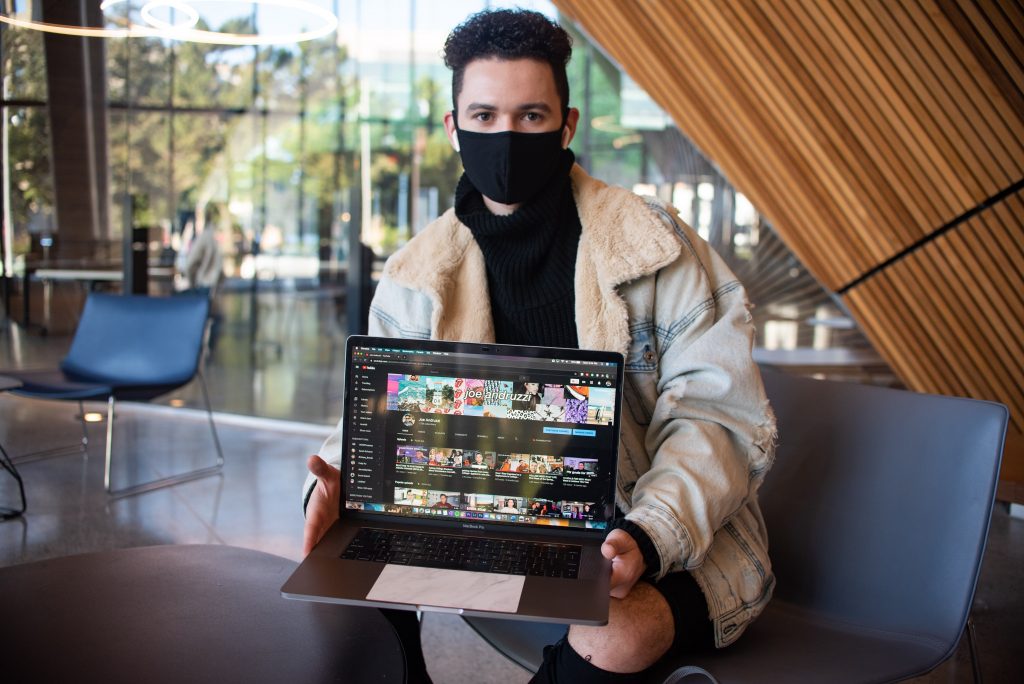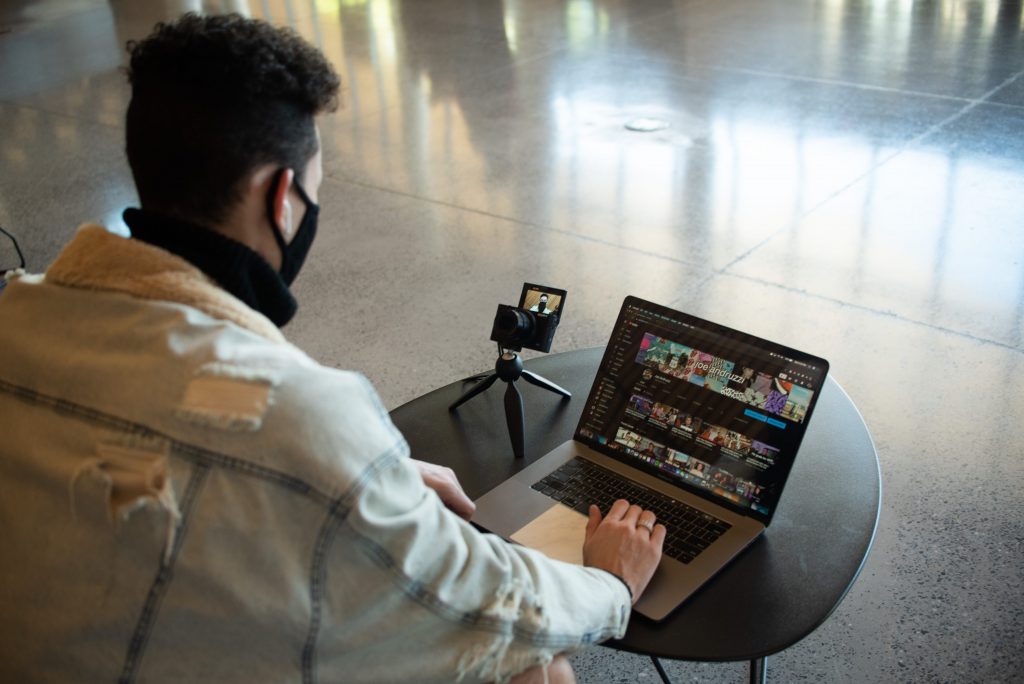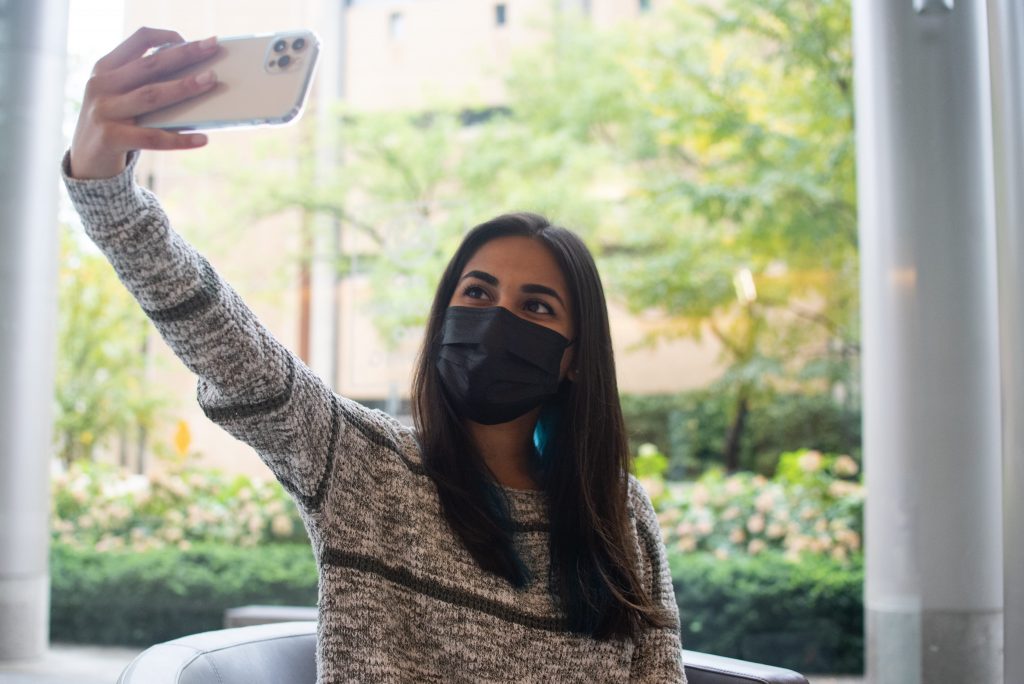With bright expressions, fast transitions, upbeat dialogue and her own title sequence, Hiba Atif addresses her nearly 5,000 YouTube followers in her off-campus apartment, showcasing various pieces of clothing she bought during quarantine as part of her back-to-school clothing haul.
”My sister got a free jeans coupon that went to my email … but I used it anyway,” she said. “I don’t buy American Eagle jeans but when they’re free, you know, you ball out a little bit.”
Since arriving at Temple University, Atif has produced her own college-related content on her YouTube channel, like dorm room tours, clothing hauls and day-in-the-life vlogs, to provide her viewers a picture of the college student experience, both on and off campus.
Atif joins a growing number of student content creators, or ‘micro-influencers,’ at Temple who are using their YouTube channels and social media platforms to connect with their audiences on topics ranging from daily student life and the Temple experience to lifestyle and beauty.
Following a growing trend across industries, like retail, technology and hospitality, companies are increasingly using micro-influencers – content creators whose audience ranges from 1,000 to 100,000 followers – to market various goods and services, said Subodha Kumar, a marketing and supply chain management professor and expert in social media advertising.
“Micro-influencers are currently dominating the digital marketing industry,” Kumar said. “It’s surely the fastest growing advertising strategy in that it provides firms the ability to target niche audiences at a low cost.”
Amid the COVID-19 pandemic, use of social media and other digital platforms has notably risen, creating an even larger demand for micro-influencer content, Kumar said.
“With fewer traditional marketing channels available due to COVID, influencers and micro-influencers are posting more and more, and therefore they are being followed and reposted more and more, and firms have noticed,” he added. “It’s really a domino effect.”
WHY MICRO-INFLUENCERS?

In the past decade, firms’ use of micro-influencers has skyrocketed across industries, mostly due to their relatively low cost — on average $200-$300 per sponsored post — as well as their niche connections to specific consumer demographics, Kumar said.
“The ability of micro-influencers to interact with their followers directly, without an intermediary, makes them extremely appealing to firms who are already struggling to be seen amid the huge amount of advertising the consumer already sees everyday,” Kumar added.
Having started his YouTube channel in middle school, Joe Andruzzi, a junior media studies and production major, saw a unique opportunity at Temple to create exclusive college-related content aimed at prospective students.
“I saw a large demand for peoples’ experiences related to college life and thought I had something unique to bring to the table being a Temple student,” Andruzzi said.
In recent years, Temple and other schools across the country have increasingly used student content creators to advertise to prospective students through social media platforms like YouTube, the New York Times reported.
During his sophomore year, Andruzzi was hired as an official student-vlogger for Temple, creating weekly content ranging from room tours to vlogs on his student experience at the university.
To date, Andruzzi’s videos posted on Temple’s YouTube page have garnered hundreds of views and he boasts about 1,700 subscribers.

Andruzzi sees micro-influencer content as the future of marketing.
“I know I at least would trust the opinion of an individual over a large company or corporation,” Andruzzi said. “People are more likely to trust what they see as a normal person sharing their experience with a brand or experience.”
Having student contributors like Andruzzi involved in the content process allows for the communication of a more authentic student life experience, which is valuable for both current and prospective students, wrote Kate O’Brien, Temple’s digital marketing manager, in an email to The Temple News.
“Digital media has allowed us to hear the concerns of our community in real time and communicate resources that can help,” she wrote.
WHAT IT TAKES
For micro-influencers like Andruzzi and Atif, their work comes with unique benefits as well as drawbacks, mostly associated with the relentless nature of content production.
“I have always really loved making videos,” Andruzzi said. “But to make this your full-time job is a lot harder than people might think. Between thinking of video ideas, to filming and editing, it can take a lot of time. On top of that you are really putting yourself out there, which can be scary.”
Atif also launched her YouTube channel in middle school after becoming interested in ‘beauty-guru’ channels, which focused on makeup tutorials and cosmetics.
“I’d say that’s the most wholesome and rewarding part of being a YouTuber, being able to help people by sharing your own experiences.”
Hiba Atif
She decided to stop filming videos at the beginning of high school, after experiencing bullying from her peers about her channel and only started again after coming to Temple.
Nicole Rafiee, a senior media studies and production major, has amassed more than 300,000 subscribers on her YouTube channel in the past two years, gaining an audience which has made her attractive for paid promotion opportunities, she said.
Rafiee’s content focuses on topics like lifestyle advice, dating tips and mental health as a college student.
“It’s in a way like any other job,” Rafiee said. “There are benefits, for example making your own schedule, but there are still quite a few challenges with this kind of work, and burnout can be a big issue especially when new content is demanded every week.”
Despite the fatigue and vulnerability that comes with being a micro-influencer, Andruzzi said the ability to engage with followers makes it all worthwhile.
“It’s incredibly redeeming when you connect with people who watch your videos and they reach out,” Andruzzi said. “It can be like small messages of support but also deeper stuff they might have related to in your videos.”
Atif has also enjoyed talking to prospective Temple students who have contacted her after watching her videos with questions about Temple and her experience as a college student.
“I’d say that’s the most wholesome and rewarding part of being a YouTuber, being able to help people by sharing your own experiences,” she added.
FAIR COMPENSATION
With the benefits of micro-influencers for marketing purposes becoming increasingly apparent, fair compensation has emerged as a topic of growing controversy, Rafiee said.
YouTubers start being compensated after they reach more than 1,000 followers as well as 4,000 hours of total viewing time on their channel for more than 12 months. After reaching this quota, YouTubers can begin monetizing their channel through advertising revenue, Forbes reported.
Once gaining a more established following, however, YouTubers can expand their revenue stream through brand deals and merchandise sales, Rafiee said.
When Rafiee started to see her following rise dramatically, she decided to hire a manager to help navigate the process of monetizing her channel.
“When I initially started getting sponsorship offers, I wasn’t really aware of what standard pay rates were for this stuff,” Rafiee said. “My manager helped me navigate those contracts and in some cases informed me some of the deals I was offered were really unfair.”
Rafiee plans on doing YouTube full time after she graduates in December, she said.

Even with their growing YouTube followings, Andruzzi and Atif are hesitant to call themselves influencers, a term both say carries a certain stigma in 2020.
“I feel like there are negative connotations associated with the word because it implies I in some way have power over people or something, when in reality I really just make videos because I enjoy it and like helping people,” Andruzzi said.
Atif also sees the ‘influencer’ designation as a potentially alienating term to describe content creators.
“What’s great about YouTube vlogs is that they offer a more personable and trustworthy perspective of your experience to people,” Atif said. “The term ‘influencer’ sort of infers the opposite. Really, we’re just students sharing our experiences and trying to connect with and help people.”